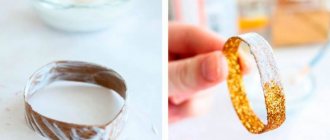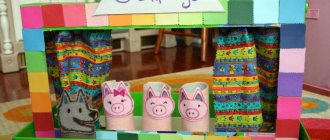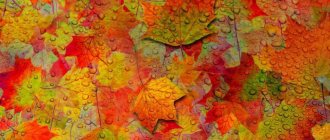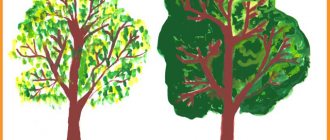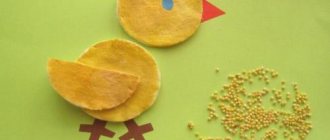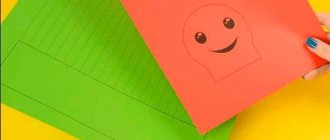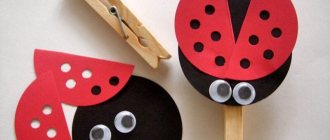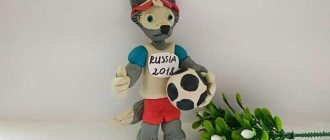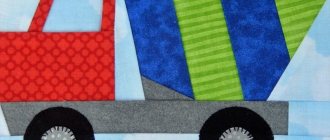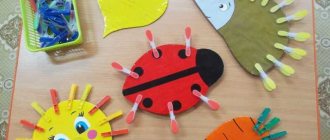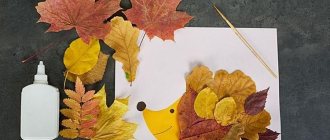Pumpkin
You will need: rolls of toilet paper or paper towels, scissors, twine or rope, stick, pva glue, for decoration - glitter or book pages.
Master Class
- Cut the sleeve into circles.
- Apply glue to one piece, sprinkle with glitter or glue a piece of page and leave to dry.
- Decorate with glitter or book pages with every detail.
- Gather the circles onto twine to form a pumpkin.
- Glue the stick into the middle of the pumpkin.
The pumpkin made from bushings is ready! You can find even more crafts made from bushings HERE.
Volume umbrella
You will need: double-sided colored paper, a compass, a simple pencil, scissors, a glue stick or adhesive tape, thick wire, thread.
Master Class
- Cut out 16 circles of the same diameter from colored paper.
- Fold each circle in half twice.
- Secure each piece in the upper round part with glue so that it is opened only at the bottom and does not open at the top.
- Take 2 blanks and glue them at right angles to each other.
- Glue the remaining pieces together in a circle, forming the upper part of the umbrella.
- Form an umbrella handle with a wire loop, then attach it.
- Prepare a piece of string and hang the umbrella by the loop.
A voluminous umbrella made of colored paper is ready! I recommend watching this video!
Application in the middle group on the theme “Autumn”
Preschoolers of the middle age group begin to get acquainted with geometric shapes, they form the idea that the outlines of natural objects can be similar to figures. For the lesson, prepare a set of colored paper, PVA and scissors. The cardboard base can be of any color.
Application technology "Autumn":
- Cut a strip of green paper and glue it to the bottom edge of a thick base - this will be grass-covered ground.
- Choose from a selection of paper in fall colors: red, purple, yellow, light brown, burgundy, orange.
- Encourage children to cut out different geometric shapes. Emphasize that the shapes must correspond to the actual shapes of the trees. Let the pupils look out the window and say what shape the crowns have: triangular, oval, round. Moreover, it is not the same, but in some trees it is more elongated or wider.
- Once the shapes are cut out, have the children glue them onto the cardboard along the center axis, parallel to the previously glued “ground”. Some figures should be slightly higher - these will be tall trees, others lower. They can be partially overlapped.
- When all the figures are glued, all that remains is to draw on the trunk and branches with a felt-tip pen.
Acorns
You will need: cardboard, scissors, glue stick, marker, templates.
Master Class
- Print out the lid template.
- Print out the box template.
- Cut them out.
- Make folds in the marked places.
- Fold the box and lid as shown in the photo instructions.
- Secure with glue.
- Make a small leaflet out of paper and draw a face for it.
- Make a whole collection of brightly colored acorns.
Acorn boxes are ready! I recommend watching this video!
You will need: a thin book without a cover or a magazine, colored paper, scissors, black marker, glue, pompom, decorative eyes.
Master Class
- Fold the top and bottom corners of the first page as shown in the photo. Repeat this process with all pages until the middle of the book.
- Fold the corners of the pages, changing their direction on the second half of the book.
- Cut out 4 paws from colored paper and mark the claws with two stripes using a marker.
- Glue the paws at different corners.
- Make a face for the hedgehog by gluing eyes and a pompom nose.
The hedgehog from the book is ready!
Rainbow in the clouds
You will need: colored cardboard, scissors, glue stick, cotton wool, stapler.
Master Class
- Cut 7 strips of paper of different colors so that each piece is shorter than the previous one. The red stripe should be the largest and the purple stripe the smallest.
- Arrange the stripes in the following order: red, orange, yellow, green, blue, indigo and violet.
- Fasten the strips of paper together using a stapler.
- Roll 6 cotton balls.
- Glue 3 cotton balls at the base of the rainbow as clouds.
Rainbow in the clouds is ready!
Corrugated paper mushrooms
You will need: corrugated paper, scissors, glue, paper straw, honeycomb paper, paints as desired.
Master Class
- Check out the mushroom template.
- Cut 2 rectangles from corrugated paper.
- Form a mushroom cap by gluing them together as shown in the photo.
- Cut out a small circle of corrugated paper and glue it in the center, covering the hole in the cap.
- Take honeycomb shaped paper, fold it several times and cut out a semicircle. Make 2 of these multi-layer blanks.
- Glue the semicircles together and form mushroom plates as shown in the image.
- Glue the plates to the bottom of the mushroom cap.
- Cover the straw with corrugated paper and glue it as a mushroom stem.
- Make a whole collection of mushrooms of different sizes.
- If desired, paint or tint them.
Corrugated paper mushrooms are ready!
Autumn leaves
You will need: double-sided colored paper, scissors, glue stick, ruler.
Master Class
- Prepare 10 squares of colored paper measuring 8x8cm.
- Take one square and fold it as shown in the photo instructions. It should look like a rhombus.
- In this way, fold a total of 6 blanks.
- Take 3 squares and fold them to form triangles.
- Glue 2 rhombuses together and one triangle in the center.
- Do this process with all the parts.
- Glue the blanks together to form a leaf.
- Make a total of 8 leaves of different colors in the same way.
- Glue the leaves together in a circle, then decorate a couple of them by making a face.
Bright autumn leaves made from colored paper are ready! I recommend watching this video!
Hedgehog made from autumn leaves
It is difficult for preschoolers of the younger group to sit still for a long time, so they have to use technically simple but exciting activities. One of these crafts is a funny hedgehog. This animal, associated with autumn and mushroom season, is easy to make from fallen leaves. First, you and your children need to collect leaves from the yard; they must be clean and fresh. They must be dried under a press so that the ornamental material turns out smooth and neat.
To create an application, prepare:
- dried leaves;
- landscape or thick colored paper;
- office glue;
- black or dark brown half bead;
- toy eye.
Instructions for creating an application:
- Prepare natural material, select leaves suitable for making the animal. One leaf should have a pointed tip - this will be the face of the hedgehog. A linden or birch leaf will do. For a back with thorns, maple specimens are optimal, but you can choose others at your discretion. Handle dried material carefully, as it is fragile.
- Glue a sharp piece of paper – a muzzle – onto a horizontal piece of paper, slightly moving it to the side from the center of the composition.
- On the back side of the tip of the nose, glue maple leaves to the muzzle. The number of copies can be any, depending on the size of the application. The main thing is that the leaves should be directed with their carved ends up and to the sides; they should not cover the hedgehog’s nose, but can overlap each other.
- Glue a black bead onto the tip of the muzzle to create a nose. Also glue on a toy eye. If you can't find it, cut out an eye from colored paper.
Garland of leaves
You will need: colored paper or cardboard, a simple pencil, leaf templates, scissors, a needle, tape, thin rope.
Master Class
- Transfer the leaf templates onto colored paper.
- Cut them out.
- Thread the leaves onto a string through a needle.
- The number of leaves and the size of the garland depends on your desire.
- Hang the garland on the wall, securing it with tape.
The garland of autumn leaves is ready!
Application “Autumn” in the younger group
The tool for creating an applique can be the hands of children. For the lesson, prepare a set of colored paper, stationery glue, scissors and decorative cardboard for the base.
Instructions:
- Select brown, red, orange and yellow paper from the paper set.
- Cut out the trunk and branches of an autumn tree from brown paper and glue it to the cardboard.
- Let the children place their hands on the other colors of paper and trace with a pencil.
- Cut out the pencil sketches.
- Invite students to glue paper blanks to tree branches.
Corrugated paper aster
- Secrets of builders: working with couplings
- DIY New Year's crafts - 9 best options
- DIY sweet crafts
You will need: corrugated paper of purple, yellow, green and light green, scissors, wire, glue gun, pencil, ruler, watercolor paints, brush.
Master Class
- Prepare a strip of purple corrugated paper 4 cm wide.
- Tint one edge of the strip with purple paint and set aside to dry.
- Fold the strip several times.
- Make cuts along the unpainted edge. The first blank is ready.
- Make the second blank in the same way, only take a purple strip 6 cm wide.
- Prepare a strip of yellow paper 3 cm wide.
- Fold the yellow strip several times and make cuts.
- Wrap the wire with a light green piece of corrugated paper and secure with glue. This will be the stem.
- Wrap a yellow blank around the end of the stem - these will be the stamens.
- Twist the ends inside the purple piece, which is 4 cm wide, using a pencil.
- Step back from the base of the stamens and glue the petals.
- Take a 6cm wide purple blank and wrap it around the bud as shown in the photo.
- Twist the ends of the petals and straighten the middle.
- Cut out 6 sepals from green paper, then glue them on.
- Cut 6 long leaves of different sizes from light green paper and glue them to the stem.
The corrugated paper aster is ready! You will find even more flowers HERE.
I recommend watching this video!
Note! Valentine's Day Crafts for Kids
DIY autumn crafts for the garden and school
Autumn crafts
- These are works made most often from natural materials. Acorns and chestnuts, cones and nuts, seeds and berries, and even colorful leaves - all these are universal craft materials that autumn is so generous with. The section presents master classes and photographs from exhibitions from kindergartens and schools. If you were asked to make a craft with your child in kindergarten on the themes: “Gifts of Autumn”, “Pantry of Autumn”, “What Autumn Brought to Us”, “Golden Autumn”, etc. — be sure to look at the materials from this section.
The change of seasons brings variety to our lives and serves as a source of creative inspiration. Autumn is a special time. The energy accumulated over the summer is looking for a positive outlet, and nature pleases with an abundance of bright colors. Clear days alternate with monotonous rains, and cheerful walks with quiet homework. This is the best time to make crafts from natural materials with your children.
Autumn inspires
Contained in sections:
Includes sections:
- Leaves. Crafts and applications from leaves 834
- Autumn bouquet. Fine art, compositions, drawing 455
- Autumn wreath 55
- Crafts from vegetables and fruits 418
- Rowan. Fine art, crafts, rowan drawings 410
Master class: application “Autumn Forest” for children of middle preschool age I bring to your attention a simple application for children of middle preschool age on the theme “ Autumn ”: 1) For work you will need: colored paper of red, orange, yellow, brown and blue , scissors, glue, black felt-tip pen. 2) On yellow and red paper.
Collective work with children of the middle group “Autumn has come to us” Topic: “ AUTUMN ” Materials: whatman paper, colored pencils, wax crayons, leaves, clover flowers, berries, maple and birch seeds, PVA glue, glue brush, oilcloth, rags for hands Goal: To develop the ability to arrange leaves of different colors and sizes on the background, to move them in search.
Autumn landscape
This leaf applique on the theme “Autumn” is intended for older preschoolers. The task greatly develops imagination; autumn leaves in the composition turn into bushes and trees: the leaf plate is the crown, the petiole is the trunk.
For work take:
- press-dried leaves of different types of trees;
- white cardboard for the base;
- PVA;
- watercolor.
Step-by-step work:
- Using watercolor paints, depict the main composition on cardboard, for example, the sky, a lake, and a strip of shore between them. Wait for the painting to dry.
- Select leaves in pairs. That is, the leaves in a pair should be as similar as possible.
- Create a forest on the shore. Glue the leaves one at a time from a pair. Glue at random, with one leaf partially overlapping another. The effect will be as if the trees are standing close to each other, the forest approaches the water itself.
- Don't forget about the reflection in the water. Glue the second pair of leaves upside down onto the image of the lake. Straight and inverted paired leaves should be joined by petioles.
Crafts on the theme of autumn with your own hands: 70 photos
Golden autumn has arrived, which means it's time for long evenings at home due to bad weather. We invite you not to waste time, but to get creative. DIY crafts on the theme of autumn will be useful for both mothers of children in kindergartens and schoolchildren, and complex compositions will perfectly decorate the house and make it cozier and warmer. Such crafts can reduce autumn depression, because any kind of creativity calms the nervous system.
- Autumn craft ideas for kindergarten
- Crafts on the theme of autumn for school
- Photos of crafts on the theme of autumn for the home
Origami “Maple Leaf”
Preschoolers in the preparatory group will be interested in learning about the Japanese art of origami. Making an applique is not difficult, the main thing is accuracy. The work requires 3 paper squares of autumn colors and stationery glue. The preferred size of the squares is 8x8 cm.
Instructions:
- Take a square. Fold diagonally. Expand.
- Place the square so that the fold is directed vertically. From its top point, fold the “wings” towards the fold. The result will be a rhombus with a more elongated upper part.
- Turn the workpiece over with the extended end down.
- Fold the protruding upper triangle under the “wings”.
- Fold the top corners towards the center line. You will get a rhombus with two small triangles.
- Return the triangles to their original state. Then remove them along the folds inside the diamond.
- Fold the top corners of the diamond down. The result was a third of a maple leaf.
- Perform similar actions with 2 other squares. Then connect them with the side edges.
The carved maple leaf is ready. All that remains is to glue it to the decorative cardboard and paint on the petiole. You can decorate walls and windows in a kindergarten with ready-made origami maple leaves.
Autumn craft ideas for kindergarten
Let's start with the simplest compositions. It is difficult for kids to make intricate crafts, so appliques made from dry leaves, chestnuts and acorns would be excellent options. Such applications will delight the little ones.
A wreath made of leaves is also a fairly simple children’s garden craft, but no less beautiful for that.
Such a wreath will be an excellent craft if you do not have time to stock up on natural materials. Just cut out the leaves from colored paper; it will be especially chic if you decorate the leaves with paints or gouache.
Very simple crafts for kids - trees with colorful foliage. There are so many options for making them!
All children love hedgehogs and many people associate this animal with autumn. Cute and prickly hedgehogs with an apple or mushroom on their back will delight children. They are made simply: as a rule, the body is made of plasticine, and needles - seeds (or other natural materials) are pressed into it.
Note! Crafts from ice cream sticks Christmas tree
Children in the older group of kindergarten are no longer so interested in making simple compositions, so we found several more complex options, but making them will not be difficult. For example, a doll with a dress from dry leaves is not difficult to make. You need to take the top half of the doll and place it in the neck of half a plastic bottle. Due to the shape of the bottle, different styles of dresses will be obtained. The leaves are glued in layers and moment crystal glue is used. Of course, girls will like this craft more than boys.
The following crafts are universal, both boys and girls will be delighted with them. Of course, these are already beloved houses made from natural materials. In such a house you can settle fairy fairies or animals, or you can leave them on their own.
Applications for kindergarten
During kindergarten classes, children do the simplest work - create silhouettes of familiar animals and birds, make simple flowers. Kids can also collect the material themselves during a walk. The main task of the teacher is to develop initial skills in working with scissors, glue, and paper.
Hedgehog
Hedgehog leaf applique is one of the first crafts in kindergarten. The kids are asked to make needles out of natural materials. Children can trace the face and nose according to the stencil suggested by the teacher.
To work you will need:
- base - cardboard, cut wallpaper, album sheet, colored paper;
- PVA glue or glue stick;
- autumn leaves with sharp edges (birch, maple, rowan, currant).
Glue can be replaced with plasticine, which children rub with their fingers according to a template pattern. In this case, the eyes and nose can also be made from plasticine balls.
Templates for applications:
If the group copes well with the basic task, you can offer a more complicated one - add a fungus laid out from leaves or berries from painted acorn caps to the needles.
Owl
An owl or an owl is a good example of symmetrical appliqué. The teacher can talk about the habits of the bird, explaining why it has such expressive eyes. You can use buttons as eyes on the applique itself.
To make it easier for children to repeat a complex silhouette, the work should be divided into stages, performed step by step:
- on a sheet of paper draw a branch on which the owl will sit;
- using a stencil or by hand, outlined the head and body at the same time - an oval;
- find the position of the eyes and wings, make the appropriate notes.
The children must handle the rest of the work themselves. They need to find leaves of the same size for the wings and line the body with small feathery leaves. The work is decorated with spectacular “ears” and paws, which should rest against a pre-drawn branch.
Owl templates for applications:
Turtle
There are several options for how to make a turtle. You can recreate the carapace ornament on the finished drawing. In this case, you will need to cut squares or hexagons from large leaves. The drawing itself, the basis for the lesson, can simply be printed.
The second option is to create a turtle from one birch or aspen leaf. Paws can be small leaves rolled into a cone or perfectly similar “helicopters” - ash seeds.
To make the picture complete, you can also consider an aquarium background. Cutting skills from colored paper will come in handy, although corals and small fish can also be made from leaves.
Turtle templates for appliques:
Hare
You can choose the bunny shape. From leaves it is easy to recreate both a running silhouette and a slant standing on its hind legs. In any case, the image will be recognizable, thanks to the long ears. At the same time, the teacher can tell you how the camouflage color of this animal changes in the fall.
Fish
A fish made from one leaf with a drawn or added tail - a level of complexity that is accessible even to kids from the nursery group. Older children can be asked to pretend to be a goldfish - by this age they already know the fairy tale of the same name.
In this case, the fish must correspond to:
- laid out from glued overlapping small leaves of scales;
- with a large beautiful tail made of a maple leaf or aspen fan;
- with a crown made of a leaf glued into a tube.
From the same leaves you can create waves on which a fairy-tale heroine rises, or algae if the underwater world is depicted.
Sun
The image of the sun in the garden can be an independent work. At school, this same element will become a template for a large panel on an autumn theme or part of a festive classroom decoration. The simplest sun is small leaves around a dinner or printed template. To make the craft more effective, children need to be shown how to carefully glue leaves in a circle in layers from outer to inner. In this case, the image will appear three-dimensional.
Autumn forest
The image of an autumn forest made of leaves develops associative thinking and imagination. At the same time, the work remains extremely simple - children just need to choose neat, spectacular leaves, stick them on the background and add trunks to them.
You can talk to older groups about perspective and contrasts, showing how yellow “birches” and “aspens” look impressive against a background of dark green “fir trees” (oak leaves or branches of coniferous trees). The concepts of “background” and “foreground” can be discussed.
Crafts on the theme of autumn for school
Crafts on the theme of autumn for school are in many ways similar to those made in kindergarten. The difference lies largely in whether the child makes them himself or with the help of his parents. Simple crafts are suitable for DIY. The eyes will come to the rescue - they will make any craft more lively and expressive.
With due diligence, these mushrooms are also not difficult for a child to make on their own.
It’s more difficult to do these options yourself, in many ways you will need the help of parents, but joint creativity brings us together.
Such crafts are suitable for competitions and require imagination from the performer. How do you like these ideas?
Photos of crafts on the theme of autumn for the home
It is not at all necessary to make crafts just because they were assigned in kindergarten and school. Many of them can be made simply to decorate your home. These completely unconventional ideas will amaze you with their beauty and give you unique pleasure and lift your autumn mood.
Dry leaf applications don't have to be simple. Sometimes they become real paintings - masterpieces. Here are just a few ideas.
Wreaths have already become a traditional home decoration, and in the autumn they can also be a small work of art.
For those who like to sew or knit, the ideas might be something like this.
If you don’t want to do anything complicated, but need to create an atmosphere, garlands of leaves or fabric of appropriate colors are suitable.
This pumpkin craft is not at all difficult to make - you will need glue and a flexible pipe for extraction. Bend the pipe to create a pumpkin shape and then spray paint it. Add a stalk - a wine cork or a suitable twig, and decorate the craft with leaves.
This miniature will delight the eye for many years. Of course, it is not so easy to make, but the result is amazing.
This kind of fun pampering with photographs will make long autumn evenings truly creative.
Candles will bring comfort on cold evenings:
A few more craft ideas for adults and children
Which crafts did you like the most?
My name is Nadezhda, I am a mother of many children. I love children and am actively involved in their development. At one time, I was looking for a site where all the information on children’s development, ideas for crafts, and poems for memorization would be collected. And also the inspiration that all mothers need, because being a mother is not always easy. Now I know such a site - I created it myself))) “Mom can do anything!” This is not just a website, this is my motto in life.
What you can do with your children on the theme of autumn from paper
Golden autumn brings inspiration with its bright outfits and seasonal colors. Nature is also not asleep - animals are preparing for a long winter, some are going to hibernate, so everyone is stocking up. This is reflected in many crafts. They can be made using different techniques and using different types of paper. In addition, this material is almost always at hand. The child will be able to make many crafts on their own, without the help of their parents, which will encourage them to express themselves more.
Autumn-themed craft ideas can be useful for kindergarten and school events, or simply for introducing your child to the season more closely. There are simpler options that even little ones can implement, and complex ones for older children.
Origami on the theme of autumn
What is the main symbol of autumn? A yellow leaf falling from a tree. Moreover, most often it is a maple leaf, which has a beautiful intricate shape. It’s easy to do, based on the video master class.
- To work you will need 3 squares of paper measuring 7*7 cm and 2 squares measuring 5.5*5.5 cm.
- Take a larger square. Bend it diagonally.
- Bend both sides to it to create an acute angle.
- On the reverse side, bend the corner of the square towards the center.
- Open the folds and tuck the bottom corner inward.
- Fold the bottom corners up.
- Tuck this bend inside the “pocket”.
- Bend the resulting corners upward to form protruding “petals.”
- Do the same with the remaining squares (including small ones).
- Using double-sided tape, connect all the parts into a single composition.
- Form a stem from a rectangle of paper of the same color as the leaf itself.
- Connect it to the sheet using double-sided tape.
The resulting sheet can be decorated at your own discretion or left as is.
What's autumn without mushrooms? Every lover of quiet hunting dreams of collecting a full basket. But you can do this without going to the forest, by making them with your own hands.
- For work you will need a square sheet of 15*15 cm.
- Fold it diagonally twice.
- Then fold it in half twice.
- Fold 3 corners to the center.
- Fold the resulting “envelope” in half so that the folded corner remains on top.
- Turn the workpiece over and fold the top corners toward the center.
- Return them to their starting position.
- Lay out the resulting back pocket so that the bend coincides with the center line.
- Fold the pocket forward along the line again.
- Bend the sharp corner towards the center.
- On the other side, do the same.
- The top and side corners can be bent, then you get a boletus mushroom or something similar. Or you can leave them spicy by making toadstool or fly agaric.
- Also bend the corner at the bottom of the workpiece.
- Turn the craft over. It turned out to be a fungus.
It can be decorated with additional elements to make it more natural.
Another origami craft is a hedgehog. Before winter, he eats up “fat” in order to sleep through all the cold and wake up safely in the spring. Therefore, in the fall it can often be seen in search of provisions.
- To work you will need a square sheet of paper measuring 21*21 cm.
- Fold it diagonally twice.
- Turn the sheet over and fold it in half twice.
- Turn over again and bend 2 opposite corners to the center.
- Bend the two sides of the workpiece to the center.
- Fold the workpiece in half.
- Fold the origami along the bend lines to form a square.
- Flip through one fold of the square and fold the top corner into the pocket. It turns out to be a beak. Return the square to its original position.
- Bend the opposite side towards the center to indicate a bend. A fold is made along it.
- Turn the workpiece over and repeat the previous step.
- Select this fold on both sides. You will get a protruding sharp corner.
- Lift the lower part towards it on both sides.
- Bend the side where the corner sticks out towards the center.
- Bend the other side to the resulting bend.
- Turn the workpiece over and repeat steps 13, 14.
- Connect the top corner to the bend.
- Bend the larger triangle on the workpiece until an acute angle is obtained.
- Unfold and bend the top corner down.
- Unfold the pocket so that the top corner “goes” into a straight line.
- On the other side, repeat steps 17-19.
- Fold the resulting “line” forward.
- “Put” the bottom part into the pocket with a corner.
- On the other side, do the same.
- Bend the “back” part of the craft a little to get curves.
- Straighten out the corner from there.
- Separate the second one from the upper “corner” and move it back.
- Fold the top corner sticking forward twice.
- On the other side, do the same.
- Place the front corner inward so that the tip remains sticking out.
- Do the same on the other side.
- Fold the hedgehog’s “face” inward.
- Tuck the nose so that it is not sharp.
- The hedgehog figurine is ready.
Autumn applications
Appliques are most often the simplest type of craft. I start with it in kindergarten, gradually complicating the composition and method of creating creative work.
There are several options for simple, but at the same time educational applications of autumn trees. Once you show your child how to fold and glue the leaves to the base, he will immediately understand it and be able to do it on his own.
The first option is with ring-shaped leaves, the second – with colored circles bent in half. A child with cutting skills will be able to make the blanks themselves. If he has not yet mastered this, then an adult will help him.
For older children, such work will be too simple, so for them the compositions chosen are more complex, using interesting techniques. The quilling technique is suitable for this type of work. The works turn out to be airy, yet voluminous and original. Twisting the strips into different shapes makes the composition incredibly beautiful, and also develops the motor skills of the child’s hands.
You can learn how to twist modules using video lessons.
Even a beginner can make a picture of a rowan branch from simple modules.
Templates and stencils for applications
If for quilling you need thin long strips of double-sided colored paper, then for simple applications it is better to use special templates and stencils. This way the details of creative work will be more accurate.
Autumn patterns using vytynanka technique
The “vytynanka” technique is similar to conventional templates and stencils. For many, it is familiar from snowflakes that are cut out of paper. Previously, the vytynanka was made in the form of a symmetrical figure: the paper was folded in half several times, and then the elements were cut out in pairs, forming gaps. Now the figures have become more complex and the resulting patterns can be different, even asymmetrical.
To make them smooth and neat, not scissors are often used for cutting, but stationery knives and razor blades. Therefore, it is better to entrust such work to older children or carry out it under the supervision of an older friend.
Volumetric crafts on an autumn theme
Volumetric figures made of paper look more realistic, especially for the design of compositions and installations.
One of the autumn holidays is Halloween. Although it came to us from the West and is celebrated recently, it has taken root among many. The main symbol of the holiday was pumpkins - bright orange vegetables with carved burning eyes.
- To work you will need yellow (orange) and green colored paper.
- Cut a yellow sheet of paper into strips.
- Cut out two circles.
- Connect the stripes to the circle using a thread.
- On the other side, also secure the stripes with a circle.
- Straighten the stripes to create volume.
- Glue a leaf and a branch at the top.
- It turned out to be a pumpkin.
It often rains in autumn. Only a bright umbrella can save you from them.
- Cut out identical circles from colored paper.
- Fold them in half and in half again.
- Glue inside to connect the quarters.
- Connect all other parts to each other in the same way.
- Open the string of quarters and connect the two ends. It turns out to be the dome of an umbrella.
- For the handle, you can use a wire, a wooden stick, or another similar device. You can also roll up a handle from a strip of paper and secure it with glue to the umbrella dome.
DIY autumn crafts
Crafts on the theme Autumn
Autumn crafts with children
Crafts made from natural materials
Autumn crafts from natural materials for schoolchildren. Master classes with photos
Autumn gives us many beautiful ideas for creativity. What beautiful autumn leaves are in the fall, you can look at them endlessly. Nature has spread a beautiful golden autumn carpet of leaves in front of us.
In autumn, you can collect not only leaves, but also acorns, cones, chestnuts, acorns and other natural materials for children's creativity.
DIY autumn flowers made from threads
Work from waste material “Autumn stars”
The work is intended for children 6-7 years old.
Can be used as a group decoration or as a gift
Goal: to promote the development of creative imagination.
Objectives: develop coordination of movements, fine motor skills of fingers, cultivate a caring attitude towards nature.
Master Class. Panel “Wonder of Autumn”
For work you will need: cardboard, fabric, scissors, pencil, Moment-Crystal glue, tree leaves, wood shavings, pencil shavings, a cutout of a woman's face from a magazine, braid.
Draw a contour figure of a girl on thin cardboard and cut it out, cut out the base for the panel from box cardboard of the desired size.
From an opaque plain fabric, cut out the background for the panel, 1.5 cm. larger than the panel size.
DIY autumn crafts at school
Master class: “Leaf fall”.
Application: Work for exhibition, interior decoration.
Dear friends, in childhood we all launched paper airplanes, made wallets, boats and steamboats out of paper, made caps and hats from newspapers. And only many years later they learned that paper folding is called a beautiful word - origami.
And I offer you a master class of work made using the modular origami technique - “Falling Leaves”.
Material: For work you will need colored paper in “autumn” shades, a ruler, a simple pencil, glue (glue stick), gouache, and a brush.
Modular origami is a style of origami in which a whole figure (work) is assembled from separate parts - modules. There are many varieties of origami modules, both flat and three-dimensional.
Master Class. Composition “Autumn Sun” (natural material).
The master class is designed for students in grades 2-3.
This craft can be used for an exhibition at the Autumn Ball holiday.
Step-by-step manufacturing process
Prepare dried flowers or dried flowers (small leaves are fine).
Materials we will need: scissors, yarn, Titan glue, any lid from large paint cans (I used a lid from Façade Paint).
DIY crafts made from natural materials.
Master class “Butterfly made from natural material”
The master class is designed for school-age children, teachers, and parents.
Purpose: Decoration in a corner of nature, interior decoration, gift.
Goal: To develop fantasy, creativity, imagination.
— Introduce a new way of using natural materials;
— Develop fine motor skills, attention, intellectual and creative activity;
— Foster a sense of love for nature.
Corn leaf doll. Master class with step-by-step photos
Crafts from talasha. DIY doll
Master Class. Corn leaf doll
This master class will be useful for additional education teachers, technology and primary school teachers, and passionate and creative parents. The doll can be made together with children over 8 years old.
The product can be used to decorate the interior or as a souvenir
Application on the theme “Applique of autumn leaves”
Master Class. Application of autumn leaves “Fairy”.
Autumn was blooming at the edges of the colors,
I quietly ran a brush across the foliage.
The hazel tree turned yellow and the maples glowed,
The aspen trees are purple, only the oak is green.
Autumn paper crafts in the preparatory group of kindergarten
Master class “Autumn trees”
Making autumn trees in different ways.
Technique: Paper plastic.
The master class is designed for preschool children aged 6-7 years.
Purpose of the master class: interior design of kindergarten groups for the autumn holiday.
Goal: development of artistic and creative abilities of children.
Crafts for the autumn school exhibition
Purpose: the master class is designed for craftswomen who have experience in threading and weaving beadwork and are passionate about this technique, since the work requires a lot of patience and some theoretical knowledge and practical skills in this field of art.
Note! DIY bird craft for kindergarten
“The sky was already breathing in autumn...”
Crafts made from natural materials for primary schoolchildren
Master class: Volumetric applique made from natural material using paper mosaic “Vase with flowers”.
The master class is designed for students of primary school age.
Goal: to create conditions for unleashing the creative potential of children through artistic creativity.
— deepen students’ knowledge and skills about paper mosaic, volumetric applique and techniques for using natural material in work;
DIY rose bouquet from maple leaves
Roses from maple leaves. Master Class
Autumn bouquet “Roses for you” Master class
Master class: DIY autumn crafts from natural materials.
Bouquet! It can be so different: candy, floral, fruity. And this bouquet is special, deciduous. It is beautiful and unusual, made of crimson autumn leaves.
Such an autumn bouquet can be a pleasant gift for your loved ones, a decorative decoration for a table and not only for autumn, show your imagination and it will delight you all year round.
Application on the theme “Autumn”. Master Class
DIY Autumn tree applique
The master class is designed for children of middle and senior preschool age, teachers and parents.
Purpose: interior decoration.
To work you will need:
DIY autumn crafts for elementary school
Application made from natural material “Trees in autumn”
Materials needed: glue, scissors, colored or white cardboard, dry leaves, a small tree branch, paints
Roses from maple leaves. Master Class
DIY crafts made from natural materials
Goal: learn to create flowers from different materials: colored napkins, maple leaves, threads and wooden sticks; work carefully.
Materials: tree leaves, threads, colored napkins, scissors, wooden sticks, tape, stapler.
Tips and tricks
As mentioned earlier, first of all it is necessary to provide instructions to the child if he has not previously engaged in such projects. It is important for parents to monitor the sequence of actions, as well as the correctness of their implementation.
It is worth giving your child as much time as possible to work independently so that he has the opportunity to show his imagination and implement this project with pleasure.
If a parent wants the child to be interested in the whole process, you can invite him to plunge into the history of the application, talk and discuss the types of applications, this stage can also be performed in the form of a game.
This approach to application can be implemented not only in relation to vegetables, but also, for example, to fruits.
Gallery of ready-made drawings and templates for cutting
Idea 1. Autumn topiary
Topiary is a decorative tree that can be used to decorate a dining table, mantel, or front door area. To make it, you can use natural or artificial materials, for example: leaves, berries on twigs, acorns, cones, chestnuts, flowers, dried citrus slices, as well as felt, sisal, linen and whatever your imagination tells you. In the next slider you can see several examples of such autumn crafts.
Next, we present to you a simple master class on making an autumn decorative tree from artificial leaves and berries.
- Clay pot;
- Wooden stick or branch;
- Two polystyrene or floral foam balls;
- Materials for decorating the crown;
- Dry moss (you can replace it with sisal);
- Glue gun and several glue sticks;
- Scissors;
- Side cutters or pruning shears;
- Acrylic paints for painting the trunk, ball and pot (optional).
Step 1. Cut a hole in the base ball with a sharp tool for the barrel, about a third of its diameter deep. Place a drop of hot glue into the hole and insert the barrel into it.
Step 2: Insert the second ball into the pot. If the ball does not sit tightly enough in the pot, place newspaper around it. Cut a hole in the ball for the trunk, 2-3 cm deep. Insert the trunk with the crown into the hole and adjust its length. Next, drop glue into the hole of the ball, place the barrel in it and begin to fill the hole with glue, placing small pieces of paper around the barrel. This is necessary so that the hot glue does not deepen the hole too much.
Step 3: Paint the pot the color you want if you don't like the original look. In this project, the pot was painted with spray paint in a dark bronze shade from Rustoleum (sold in construction stores, for example, in Leroy Merlin).
Remember that the design of the pot should be simple and unpretentious so as not to distract attention from the crown. If necessary, paint the barrel and/or balls at this stage. It is advisable to paint the balls so that the gaps between the decorative details are invisible.
Step 4. While the paint on our blank is drying, sort the decorative parts by type and size. If you use artificial leaves, flowers and berries with a wire base, then when cutting them, leave “stems” about 2 cm long. This is necessary in order not only to glue the parts, but also to stick them into the ball - then they will hold more securely . If the “stems” do not have wire, then it is better to cut the parts “at the root”.
Step 5. Now it's time for the fun part - creating the crown. First, evenly distribute and glue the largest parts onto the ball, then the middle ones. Finally, fill in the gaps with small embellishments.
- Step 6. Well, that's all, all that remains is to decorate the ball in the pot with dry moss or sisal, after treating it with glue.
Detailed instructions for application
It is important to remember that each step is important and it is not recommended to skip it. Omission of points is allowed only when the application is being improved and modified.
All details must be prepared in advance so that the child and parent are not distracted by preparations during the process of creating the application itself.
For themselves, parents can make a short note on the topic of the application, so that in the process of achieving the set goal they do not get confused or confuse the sequence of actions. In the case when the application is performed in an older group, you can invite the child to independently monitor the completion of the stages.
An interesting solution to note-taking would be sketches of all points made together with the child.
